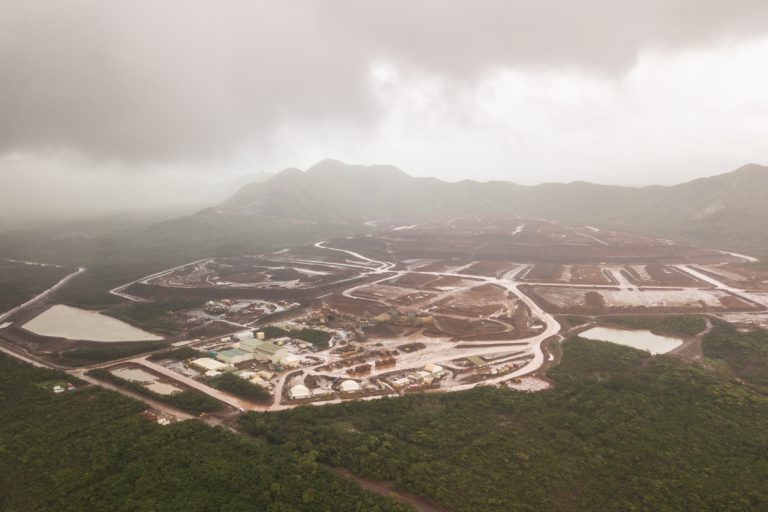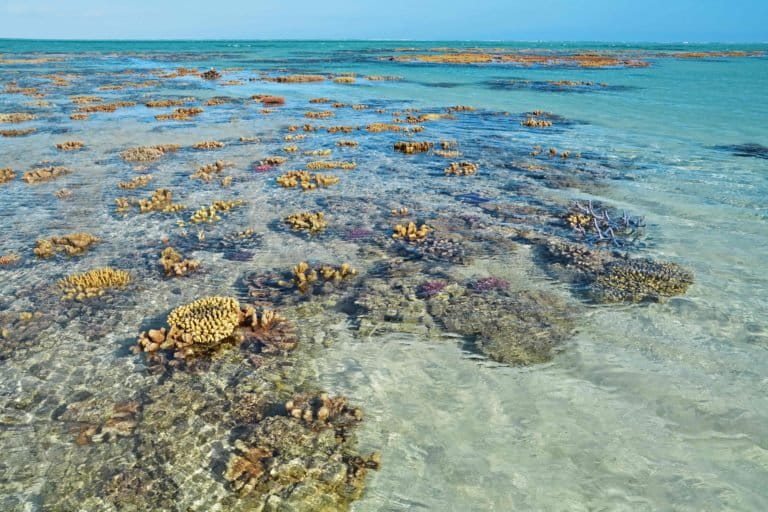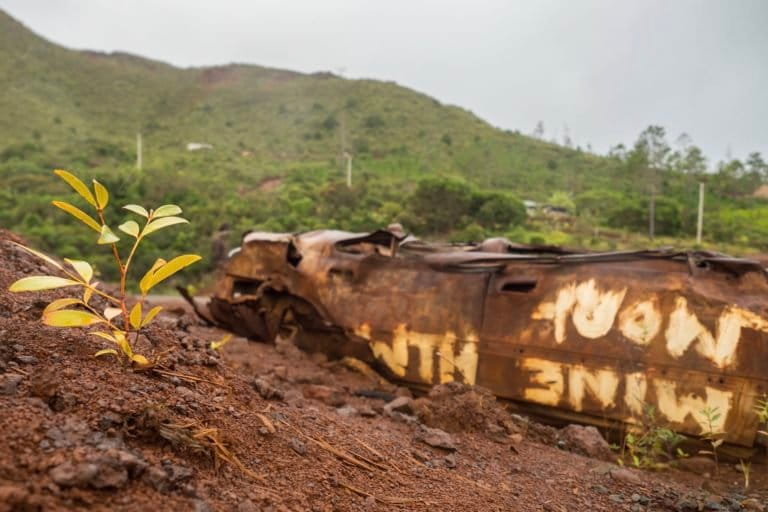- Nickel mining in New Caledonia, a French overseas territory in the south Pacific, is receiving international attention after the electrical vehicle giant Tesla recently invested in its largest mine, Goro.
- The mine has been plagued by environmental and social issues for the last decade. It is related to five chemical spills and Indigenous Kanak struggles for sovereignty over its resources.
- Raphaël Mapou is a Kanak leader who established the environmental organization Rhéébù Nùù in 2002 as a means to address concerns about the effects of mining at Goro.
- In an interview with Mongabay, Mapou talks about the legacy of Rhéébù Nùù and if a change of ownership at Goro, combined with Tesla’s investment, can deliver positive outcomes for surrounding communities.
GORO, New Caledonia – Known widely as the “Madagascar of the Pacific,” New Caledonia is coated in remnant Gondwana rainforest and surrounded by reefs rich in marine life that constitute one of the largest marine parks on earth. It is a French territory located approximately 1,470 kilometers (900 miles) northeast of Brisbane, Australia.
Despite its size, New Caledonia punches far above its weight ecologically. It houses the longest continuous barrier reef in the world and is internationally renowned for its plant species, over 80% of which are endemic.
The territory is also one of the world’s largest producers of nickel and holds a quarter of the earth’s known reserves.

Despite the wealth nickel mining has produced on Grand Terre, the principal island of the nation, the extraction of the metal has had an ambiguous social and environmental impact on the country’s Indigenous people, the Kanak community. With the archipelago colonized by the French in the mid-19th century, there is still little formal recognition of the Kanak community’s legal and customary attachment to their traditional lands.
The effect of this history is being played out at New Caledonia’s largest mine, Goro, and the plant that services it. Plagued by environmental and social issues, including five acid spills in ten years, the last decade at Goro has seen waste mismanagement, land clearing and sediment run-off into the sea. This has reportedly had a detrimental effect on the barrier reef that wraps around the island like a protective cloak.
Last year, it was announced that Tesla, one of the world’s best-known manufacturing companies, would invest in Goro following the sale of the mine to a locally-backed consortium, Prony Resources. Vale, a Brazilian mining company and the world’s top nickel producer, previously owned the mine.
The electrical car manufacturer’s “technical and industrial partnership” with Prony Resources has raised the prospect of Goro becoming a key source of the world’s nickel production. Some locals hope this partnership will lead to an improved relationship with the local Kanak communities and environmental management at the site. Fifty-one percent of the new consortium’s shares are owned by New Caledonian interests which include local communities and mine workers.

Others, who recall the mine’s environmental record—including the lingering legacy of five chemical spills and cases of acid leaching, are more skeptical.
One of country’s leading observers and stakeholders in Goro and the greater south region of Grand Terre is Raphaël Mapou. A Kanak leader and former mayor of the town of Yatè, Mapou holds a PhD in Law and has been involved in New Caledonian politics for decades.
In 2002, he established the environmental watchdog organization, Rhéébù Nùù, to keep an eye on the Goro mine and to insist on proper management at the site. As well as lobbying the government, Mapou and the organization have been pivotal in commissioning scientific reports on environmental concerns. Some of these reports are still pending results that show the full effect of acid leaks on Kanak customary lands. This July marks twenty years of Rhéébù Nùù’s continuous operation.
Mapou spoke to Mongabay about what the new ownership of Goro will mean for the Kanaks and for the region’s ecological integrity.
INTERVIEW WITH RAPHAËL MAPOU
Mongabay: You come from the Grand Sud or “Grand South” region of New Caledonia. What is the significance of the country’s landscape and biodiversity to the Kanak people?
Raphaël Mapou: The southern region is centered on a plateau. It lies on the ocean, in the south of the island, on the Havana and Teal Canals, between Prony Bay and [the town] of Yatè. This vast plateau, where large nickel and cobalt mining deposits are located, is at the center of Kanak legend and traditions in terms of plant collections and of places of confrontation and wars.
Most of the vegetation we have in the south of the island is endemic and it is a region that contains many of our medicinal plants. Our ancestors lived on the coast and [the plateau] is a place of passage and migration from one coastal region to another. The legends of the Kanak people speak of the importance of rivers related to the ocean. The coral reef is a very important source of food for Kanaks.

Mongabay: Nickel is mined extensively in New Caledonia, and the southern refinery project, known as Goro, lies in the Grand Sud area. Twenty years ago, you set up the environmental organization Rhéébù Nùù as a means to keep an eye on the mine’s operations. What drove you to do this?
Raphaël Mapou: INCO, a Canadian mining company, sought to extract nickel during the Second World War, but the French state prevented it. In 1991, INCO returned, supported by [then] president of the Southern Province, Jacques Lafleur.
We were informed of the environmental and ecological risks posed by the plant, as they proposed to use a process called “high-pressure acid leaching” to extract minerals. This chemical process was completely new to New Caledonia.
The decision to build the commercial plant was eventually made in 2001, a decision that was taken urgently for political reasons, and as a result, the impact studies had not yet been completed. This led the Kanak people and their chiefdoms, or customary authorities, to request a postponement of construction.
It was during this time that a natural event occurred. A whale calf was attacked and eaten in the nearby ocean, which was understood by the Kanaks as a symbol, and as a warning. For the Kanak people, a blue calf represents southern New Caledonia, which was going to be devoured by large sharks in Prony Bay—in other words, by multinationals.
This natural event served as a catalyst for Indigenous consciousness and the cultural link between the Kanak clans of the south and their natural spaces. We did not want our lagoon to be polluted with heavy metals and mining waste and our lands and forests to be destroyed.
That’s why we created Rhéébù Nùù, which means “eye of the country” on July 14, 2002.

Mongabay: What issues did you identify at Goro, particularly in regards to the marine environment?
Raphaël Mapou: The first project involved the construction of a pipeline that would transport waste from the plant, out beyond the coral reef and into the ocean. Back then, in 2000, the only known nickel chemical plant residue storage models were in Cuba and Australia.
In addition, when it rains, in this very rainy region, the amount of mud created by mining or runoff is very difficult to contain. In 2002, following the first earthworks and clearing work, the lagoon began to change color. It became ore-red.
That year, in 2002, the Rheébù Nùù committee was in contact with Indigenous peoples and environmental organizations, including Mining Watch in Canada. We were also in contact with the inhabitants of Madang Province in Papua New Guinea, where a similar acid leaching plant project was being built by a Chinese company.
With all this information and, in particular, the expertise provided by international NGOs including Mining Watch, we refused this project which sought to discharge solid residues into the marine environment.
Mongabay: How did you continue this fight?
Raphaël Mapou: All these events occurring at this time led us to fight on several fronts. INCO tried at all costs to confirm the political decision taken by the southern province [to allow the project to go ahead], which was in turn supported by the French state.
There was a blockade that restricted access to both the mine and plant, which stopped construction for two months. Rhéébù Nùù followed this by demanding further impact studies and scientific counter studies on environmental issues. For example, we requested reports about the discharge of liquid effluents from the plant into the marine environment, the bioaccumulation of heavy metals and the protection of biodiversity.

Then, in 2007, the Brazilian multinational, Vale, acquired the project at Goro. We continued the discussion [about the mine’s future], and Vale agreed to review certain standards such as the appropriate levels of manganese [being used] in order to comply with international standards.
Through this, the Rheébù Nùù committee focused on defining a peaceful framework for relations between industrialists and Indigenous peoples, which led to the signing of the Great South Sustainable Development Pact. [This is a framework] which is based on the principle of “prior free and informed consent” framed by the Declaration on the Rights of Indigenous Peoples.
Rhéébù Nùù spearheaded this fight. We were supported by the chiefdoms of [the regions of] Goro, Touaourou and Unia and Saint Louis. We were also supported by Kanak nationalist parties and unions.
Mongabay: What is the legacy of these environmental issues? Are you concerned that these problems will continue following the sale of Goro to Prony Resources?
Raphaël Mapou: Our first response was to question the technical, scientific, environmental and financial credentials of the buyer.
Vale had lost a lot of money at the mine, and similar risks were present at Vale’s iron factories in Brazil. There, tailings dams had collapsed, causing dozens of deaths and hundreds of victims, not to mention irreversible environmental pollution.
The environmental issue that has focuses our attention is therefore [Goro’s tailings dam]. It contains 40 million tons of residue. We are concerned about its strength and what will become of this waste.
We were far from reassured with [the candidates considered to buy the plant]. We tried to make the CEO of Vale in New Caledonia understand that, for us, other candidates who submitted to the tender [for the purchase of Goro] were stronger in every respect and presented all necessary assurances for the environment.

As a result, the first part of the negotiations [about the future of the mine] focused on scientific expertise. This was as a means to establish the stability of the dam, as well as environmental concerns such as the discharge of heavy metals into the sea, air pollution and the preservation of biodiversity.
These negotiations were able to take place, and in the end, we managed to reposition this operation on a good basis. The Swiss company Trafigura will help manage the plant and New Caledonian interests have become the majority [shareholders]. [A] political agreement signed on March 04, 2021 [with Prony Resources] sealed a new agreement [that] It respects the mechanism of the Greater South Sustainable Development Pact.
Mongabay: Tesla, one of the world’s wealthiest manufacturing companies, is investing in the Goro mine. Do you think this will have any influence on environmental management practices at the site, given the company’s international influence?
Raphaël Mapou: The partnership with Tesla is likely to limit air pollution and keep the release of carbon dioxide [from the mine] to a strict minimum. The renewable energy investment program that has been announced [and signed in the above agreement] will ensure that nickel and cobalt from the mine can be “greened.”
[Ed. Prony Resources intends to halve its carbon emissions by 2030. The company and local interests argue that Tesla brings technical expertise in the improvement of the industrial process and sustainable development.]
This new chapter of the southern plant will be profitable and we will ensure that [through this] there is continuous investment in the environment.
And I can say that today’s young people, young Kanak leaders, will never allow accidents such as the chemical spills that the plant has had in the past.

Mongabay: Demand for lithium-ion batteries has raised production rates of nickel in other countries with similar environmental values to New Caledonia, such as the Philippines and Indonesia.
Are you able to reflect on what you have learned over the last twenty years that may be of use to Indigenous peoples in those countries, in particular, for those who are facing the prospect of large-scale mining on their traditional lands?
Raphaël Mapou: Uncontrolled industrialization is not a long-term, correct and sustainable development strategy, I think. We are poorer today than twenty years ago.
Before 2000, we had only one nickel processing plant and half of the ore was exported. Since [the arrival of] Vale, New Caledonia has acquired four new factories.
[My advice would be that] before the implementation of any further major industrial project, impact studies must be conducted correctly on all levels—environmental, socio-cultural and economic. On a general level, the population must be able to bear the direct and induced effects imposed by any new development model.
In New Caledonia, we are gradually succeeding in regaining possession of our mining deposits, which the colonizer [France] and mining companies have confiscated free of charge for more than one hundred and fifty years. This is the case of the Koniambo mining deposit in the north of New Caledonia and now for the Goro deposit.
This theft by colonizing [countries] must stop because minerals have an important intrinsic economic value that can benefit Indigenous peoples and the development of new states.
Mongabay: Is there legislation in New Caledonia regarding customary lands where Kanak people have rights over their traditional territory?
Raphaël Mapou: This is [a] complex [question], because only 20% of the land in New Caledonia is recognized as the customary territories of the Kanak people.
The French state has always denied the Kanak [customary land rights] and given rights to mining companies. [For example], we have always claimed the mountains as the natural heritage of the Kanak people.

This claim [to the mountains] has allowed the chiefdoms of Goro and the south of New Caledonia to demand [the state] respect the principle of prior and informed consent. In order for the Goro plant to be sustainable, respect for this principle [would be] required. It will help build a continuous dialogue.
Mongabay: You have been involved in politics in New Caledonia for a long time. How do you balance being a leader in the Kanak community, with its cultural and customary associations, and taking part in the broader political system?
Raphaël Mapou: New Caledonia has always been under the French model of government. I am not entirely satisfied with this because it has conditioned a model of neo-colonialism. This model does not change the legal framework; it only structures governance at an elite level.
However, an important thing about New Caledonia is that we have always had our chiefs, our chiefdoms and the clans that compose them. This is a traditional, customary system, and it must be successfully structured so that customary law can collaborate with democratic law.
To change and allow people to develop in our country, Kanak rights and the Indigenous value system must be recognized at the same level as republican law. This way, we can have a system of legal pluralism.
Mongabay: What lies ahead for Rhéébù Nùù?
Raphaël Mapou: We are preparing the new generation to live up to environmental and civilizational challenges. In the new project [at Goro], we are stakeholders and, therefore, actors. My hope is that, through daily monitoring, we will obtain objective answers on the environment and that this chemical plant will be fully controlled.
We will follow every step, everything that happens. And we will ensure that the new generation is properly trained [to deal with environmental challenges] and [are] prepared for the future.
See related article about Tesla’s investment in the Goro mine and the mine’s troubled environmental record, here.
Banner image: Raphael Mapou, Kanak leader who established the environmental organization Rhéébù Nùù. Image courtesy of Lachie Carracher.
Related listening from Mongabay’s podcast: We look at whether or not mining is compatible with the clean energy revolution. Listen here:
FEEDBACK: Use this form to send a message to the author of this post. If you want to post a public comment, you can do that at the bottom of the page.
